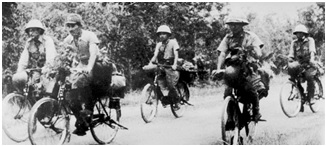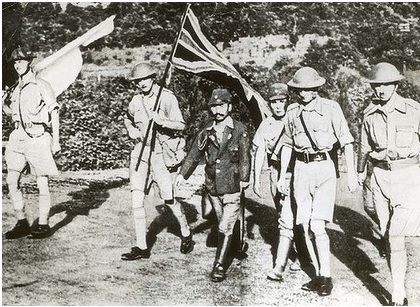Singapore: “An Impregnable Fortress”
In the 1930s, Singapore – a tiny island off the southern coast of Malaya – was viewed as a jewel in the crown of the British Empire. It was regarded as an unassailable island due to its strong seaward defenses. Singapore’s defenses were concentrated at their naval base in order to protect the harbor from sea-based attacks. Unfortunately, this strategy left the entire northern shore, facing Malaya, vulnerable. This flaw would be Singapore’s demise.
The Japanese Invasion of Malaya
Singapore’s defensive flaw prompted the Japanese to proceed to Singapore through Malaya. And that is what they did. On 8 December 1941, the Japanese forces – led by Lieutenant General Yamashita – landed at Kota Bharu on the border of Malaya and Thailand.
This invasion was done simultaneously with the attack on Pearl Harbor to prevent America from interfering in South-East Asia. As they advanced down the east and west coasts of Malaya, they seized British strongholds and captured prisoners with ease. The conditions were harsh as both sides had to trek through thick jungles and dirt tracks along with heavy rain and flooding.
However, the Japanese were intelligent and inventive by invading Malaya on bicycles. Despite being inferior in terms of number, the Imperial Japanese Army steamrolled the Allied forces further and further until they retreated to Singapore.
On 31 January 1942, the causeway joining Singapore to Malaya was blown up, dissolving Singapore’s link with Malaysia as a last attempt to stop the Japanese. At that point in time, it seemed that the Japanese were surging south while the British could do nothing.
Timeline of the Battle for Singapore
| DATE | EVENT |
| 8 December 1941 | Japanese divisions land at Kota Bahru (Malaya) |
| 7 December 1941 | Japanese bomb Pearl Harbor |
| 10 December 1941 | Japanese sink Britain’s two main warships: the Prince of Wales and Repulse |
| 15 January 1942 | General Percival ordered the remaining 30,000 Allied troops in Malaya to retreat to Singapore |
| 17 January 1942 | The British blow up the causeway linking Singapore to Malaysia in an attempt to stop the Japanese |
| 8 February 1942 | The Japanese land in the northwest of Singapore |
| 15 February 1942 | The British surrender to the Japanese at the Ford Motor Factory |
The Fall of Singapore
On 8 February 1942, the first Japanese divisions landed in Singapore assaulting the landward side where the British had left inadequately defended. Singapore’s defenses – who were led by Lieutenant General Arthur Percival – were ineffective as they were overwhelmed by the Japanese. Additionally, Singapore no longer had any ships to support them as HM Ships Prince of Wales and Repulse were sunk in December 1941.
Within two days, the Japanese had conquered one-third of Singapore. As the fighting continued in Singapore, the water supply lessened, ammunition stocks dwindled and petrol was almost non-existent for both armies. The local Chinese and Indian populations suffered shockingly from the Japanese air raids. However, the civilians continued to assist the Allied soldiers the best they could.
Facing an increasingly dire situation, General Percival surrendered to the Japanese on 15 February 1942. Approximately 15,000 Australians became prisoners of the war under inhumane living conditions. In addition, roughly 1,800 Australians died during the Malayan Campaign and the Battle for Singapore. The British fortress, which was once thought impenetrable, had fallen in less than a week.
The Significance of Singapore’s Invasion
Malaya and Singapore were imperative to the Japanese Empire as it was linked to their expansion and aggressive nature. Japan also had almost no natural resources which encouraged them to invade other countries such as Malaya who had an abundance of resources. Their aim sought to secure new sources of raw materials in order to fund their expansion in South-East Asia.
In history, a significant occasion is described as an event that causes major change at that time whilst leaving lasting impressions on our current lives. Therefore, Singapore’s invasion is significant. It was the largest surrender in British military history; a humiliating defeat. People today still argue that it always will be Britain’s most inglorious downfall.
Singapore had been the cornerstone of imperial defense in the Far East. For British Prime Minister Winston Churchill, it was “the worst disaster and largest capitulation in British history.” Singapore’s downfall demonstrated the power and ruthlessness of the Japanese military.
In contrast, it also displayed how weak and somewhat arrogant the British Empire had become as the Commander of the Australian Forces in Singapore said, “The whole operation seems incredible: 550 miles in 55 days – forced back by a small Japanese army of only two divisions, riding stolen bicycles and without artillery support.”
For Australians, it revealed that Australia could no longer rely on British protection as well as the fact that a Japanese invasion of Australia was indeed a real danger. Furthermore, the worst military disaster in British history also undermined the myth of white supremacy in the colonial period as Japan, an Asian power, had thoroughly defeated and discredited the European system of imperialism.
A combination of superior Japanese leadership, training, equipment, and boldness allowed the Japanese to defeat a numerically superior enemy who showed no shortage of arrogance, passiveness, and indecision.
References
Australiangeographic.com.au, (2014). On this day: The fall of Singapore. [online] Available at: http://www.australiangeographic.com.au/blogs/on-this-day/2012/02/on-this-day-the-fall-of-singapore [Accessed 29 Jul. 2014].
Encyclopedia Britannica, (2014). World War II (1939-45) :: The fall of Singapore. [online] Available at: http://www.britannica.com/EBchecked/topic/648813/World-War-II/53557/The-fall-of-Singapore [Accessed 29 Jul. 2014].
Johnson, D. (2014). Battle Of Singapore. [online] History Net: Where History Comes Alive – World & US History Online. Available at: http://www.historynet.com/battle-of-singapore [Accessed 3 Aug. 2014].
Section117.com, (2014). Section 117 » A Brief History of the “Fall of Singapore”. [online] Available at: http://www.section117.com/?p=353 [Accessed 3 Aug. 2014].
Trueman, C. (2014). The fall of Singapore. [online] Historylearningsite.co.uk. Available at: http://www.historylearningsite.co.uk/fall_of_singapore.htm [Accessed 30 Aug. 2014].

